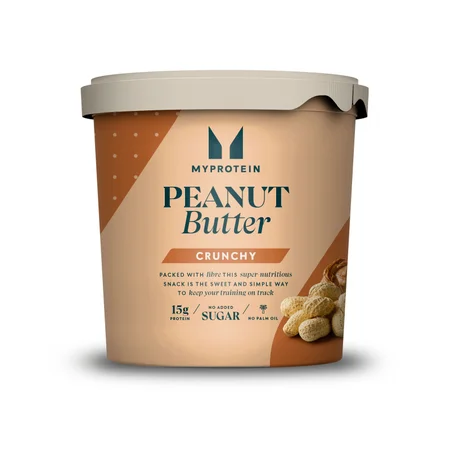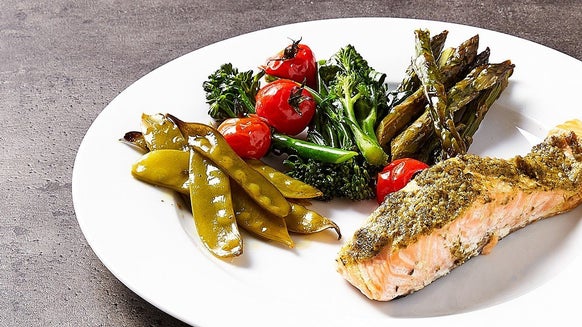Which Foods Can You Eat On A Keto Diet?

If you’re keeping up with the latest diets trends, then the keto diet seems like the obvious option. Starting out can be pretty confusing though — what can you actually eat? Don’t worry, we’ve got you. When following a ketogenic diet, you want to choose healthy foods from each group that are the lowest in carbs and ideally contain healthy fats. Here’s what you can eat to keep you in ketosis.
Seafood

Seafood and shellfish are high-protein, low-carb, healthy options on almost any diet — including keto. Tuna and salmon are packed with heart-healthy omega-3 fatty acids. Shelf-stable, cheap options include sardines and anchovies packed in oil. From the shellfish family, clams and mussels contain high levels of fatty acids. Eating/consuming seafood at least twice a week is a good recommendation for any diet.
| Seafood (100g) | Fat | Protein | Carbs |
| Salmon | 8g | 22g | 0g |
| Sardines | 18g | 22g | 0g |
| Tinned Tuna | 31g | 5g | 0g |
| Tinned Anchovies | 16g | 35g | 0g |
| Mussels | 20g | 2g | 4g |
Low-carb vegetables

Vegetables are high in fibre and typically low in carbs, making them the healthiest foods in a ketogenic diet. To choose the lowest in carbs, stick with cruciferous vegetable (broccoli, cabbage, cauliflower, Brussels sprouts) and those with a high water content (celery, tomatoes, bell peppers). Onions and garlic are great low carb veggies that can add a lot of flavour to your dishes.
| Vegetables (100g) | Fat | Protein | Carbs |
| Broccoli | 0g | 3g | 7g |
| Cabbage | 0g | 1g | 6g |
| Cauliflower | 1g | 3g | 4g |
| Brussels Sprouts | 1g | 3g | 4g |
| Pepper | 0g | 1g | 9g |
High-fat dairy

Milk is naturally high in carbs due to the lactose (milk sugar) it contains. To get your calcium foods on a keto diet, focus on some of the following sources:
C heese : Hard varieties like cheddar are usually lower in carbs than goats’ cheese or feta.W hipping cream is a good option if you want some dairy in your coffee.
B utter can be consumed in small amounts (try not to use too much, as it’s high saturated fat).O live oil orC oconut oil are great alternatives to butterF ull fat, unflavo u red cream cheese ,yog h urt , orcottage cheese : Yoghurt, cream cheese, and cottage cheese should be used more like condiments – in small amounts because they are the higher-carb options in this list.
| Dairy (100g) | Fat | Protein | Carbs |
| Cheddar Cheese | 33g | 25g | 1g |
| Butter | 81g | 1g | 1g |
| Olive Oil | 100g | 0g | 0g |
| Coconut Oil | 100g | 0g | 0g |
| Cottage Cheese | 4g | 11g | 3g |
Animal protein sources

All meats, poultry, and pork products are low in carbs, but their fat content varies. Although a giant pile of bacon sounds delicious, it isn’t the healthiest option. Try to make good choices from this group by looking for organic, free range beef products, and minimally processed pork products (limiting sodium intake). Dark meat chicken or turkey has more fat to balance your macro intake. Eggs are a good high-protein breakfast option, or snack throughout the day.
| Animal Protein (100g) | Fat | Protein | Carbs |
| Chicken | 2g | 24g | 0g |
| Lean Beef Mince | 10g | 20g | 1g |
| Pork Loin | 5g | 29g | 0g |
| Turkey | 1g | 16g | 3g |
| Eggs | 12g | 11g | 1g |
Vegan Protein Sources

Your protein doesn’t have to come from an animal, as this can often be high in saturated fats, you may wish to opt for some plant-based options too. In fact, if you can follow a keto diet as a vegan or vegetarian too as long as you carefully track your macros. Be aware that common plant-based sources of protein such as beans and pulses also contain carbohydrate, so you may need to avoid these too. Foods such as nuts and seeds, as well as soy products can be a good option.
| Vegan Protein (100g) | Fat | Protein | Carbs |
| Tofu | 7g | 13g | 1g |
| Walnuts | 65g | 15g | 14g |
| Peanut Butter | 53g | 24g | 10g |
| Chia Seeds | 29g | 22g | 3g |
| Brazil Nuts | 66g | 14g | 4g |
Snacks

Nuts and seeds are packed with healthy fats and are low in carbs — watch out for any that are flavoured or have a tonne of salt added though. Avocado and guacamole are great keto snacks to eat with low carb veggies. Olives and hummus are other easy options, while you can always combine low carb foods from other groups — like meat and cheese — just skip the crackers.
| Snacks (100g) | Fat | Protein | Carbs |
| Hummus | 25g | 7g | 11g |
| Avocado | 15g | 2g | 9g |
| Olives | 22g | 1g | 1g |
| Spreadable Cheese | 22g | 6g | 4g |
| Ham | 3g | 22g | 2g |
Take home message
There are healthy, low-carb options in all of the foods groups. Just try to select those which contain healthier fats (plant based instead of animal fat) and the right amount of protein foods to make sure you’re hitting your macro goals to stay in ketosis.

Claire is a Registered Dietitian through the Academy of Nutrition and Dietetics and a board-certified Health and Wellness Coach through the International Consortium for Health and Wellness Coaching. She has a Bachelor of Science in Biology and a Master’s degree in Clinical Dietetics and Nutrition from the University of Pittsburgh.
Talking and writing about food and fitness is at the heart of Claire’s ethos as she loves to use her experience to help others meet their health and wellness goals.
Claire is also a certified indoor cycling instructor and loves the mental and physical boost she gets from regular runs and yoga classes. When she’s not keeping fit herself, she’s cheering on her hometown’s sports teams in Pittsburgh, or cooking for her family in the kitchen.
Find out more about Claire’s experience here.






